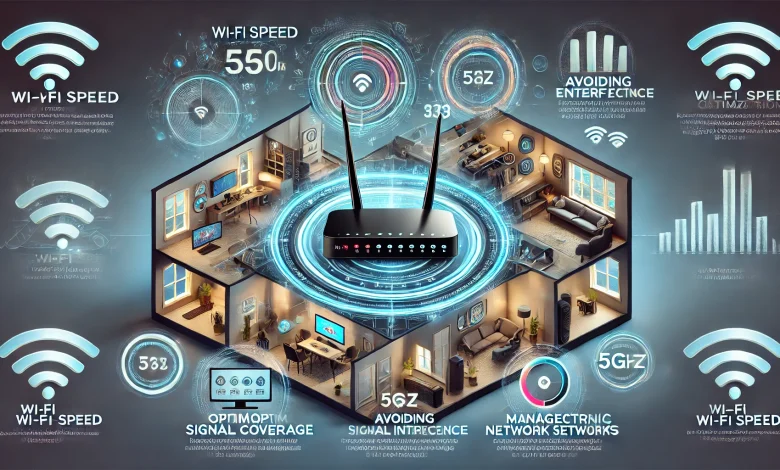Increase Wi-Fi Speed: 15 Proven Ways to Boost Your Network Performance

Table of Contents
1. Introduction to Wi-Fi Speed Optimization
Fast and stable Wi-Fi has become a necessity in today’s digital world. From remote work to streaming and gaming, a reliable connection ensures seamless experiences. Unfortunately, many households and businesses face challenges such as lag, buffering, and dropped connections. Understanding the root causes of these issues and applying targeted solutions can significantly increase Wi-Fi speed and stability.
2. Understanding Wi-Fi Speed and Performance
Wi-Fi speed is influenced by several factors, including hardware, environmental conditions, and internet service provider (ISP) limitations. Bandwidth represents the capacity of your connection, while speed refers to how quickly data transfers over your network. Common Wi-Fi standards, such as 802.11ac and 802.11ax (Wi-Fi 6), determine the maximum potential speed. Additionally, even with advanced routers, your ISP’s speed directly impacts overall performance.
3. Diagnosing Wi-Fi Speed Issues
To increase Wi-Fi speed, start by testing your network performance using tools like speed test apps or network analyzers. Look for bottlenecks caused by outdated routers, overcrowded channels, or ISP restrictions. Common signs of slow Wi-Fi include buffering during video playback, delayed responses in online gaming, or long download times. By pinpointing the issue, you can apply appropriate solutions.
4. Optimizing Router Placement
Router placement plays a critical role in increasing Wi-Fi speed. Position your router in a central location, away from walls, furniture, and electronic devices that can cause interference. Ideally, routers should be elevated, such as on a shelf or wall mount. For larger homes or offices, consider adding Wi-Fi extenders or a mesh system to ensure consistent coverage across all areas.
5. Updating and Upgrading Equipment
Keeping your router’s firmware updated can significantly enhance performance. Upgrading to modern routers, particularly those supporting Wi-Fi 6, can provide faster speeds and better device handling. When choosing a router, consider whether a single-band, dual-band, or tri-band model suits your needs. Dual-band and tri-band routers are ideal for reducing congestion and increasing Wi-Fi speed, especially in busy households.
6. Managing Network Traffic and Bandwidth Usage
To increase Wi-Fi speed, manage network traffic effectively. Use Quality of Service (QoS) settings to prioritize bandwidth for critical devices. Identify devices or apps that consume excessive bandwidth, such as streaming platforms or large downloads, and limit their usage. Setting up a guest network can also reduce congestion by isolating non-essential devices.
7. Optimizing Wi-Fi Settings
Adjusting Wi-Fi settings can improve network performance. Choose the best channel to minimize interference from neighboring networks. For faster speeds, use the 5GHz frequency band for devices close to the router and reserve 2.4GHz for those farther away. Enable advanced features like beamforming and MU-MIMO to direct signals to specific devices and enhance overall speed.
8. Reducing Interference from Other Devices
Wi-Fi interference from electronic devices and neighboring networks can significantly degrade performance, leading to slower speeds and connectivity issues. To effectively increase Wi-Fi speed, consider the following strategies to minimize interference:
- Identify Sources of Interference: Common household devices such as microwaves, Bluetooth devices, baby monitors, cordless phones, and smart home appliances operate on the 2.4GHz band, which can interfere with Wi-Fi signals. Place your router away from these devices to reduce disruption.
- Switch to the 5GHz Band: The 5GHz frequency band offers more channels and less interference compared to 2.4GHz. Devices that support 5GHz should be prioritized for bandwidth-intensive activities to increase Wi-Fi speed and stability.
- Use Wired Connections: For critical devices like gaming consoles, smart TVs, or workstations, using an Ethernet cable provides a direct and interference-free connection, enhancing speed and reducing latency.
- Optimize Wi-Fi Channels: Use Wi-Fi analyzer tools to scan your network and identify the least congested channel. Manually setting your router to a less crowded channel can prevent overlap with neighboring networks and boost performance.
- Enable Dual-Band Operation: Modern routers allow simultaneous operation on both 2.4GHz and 5GHz bands. Assigning devices based on their distance and bandwidth needs can balance the load and reduce congestion.
- Distance from Other Electronics: Ensure your router is positioned away from large metal objects, mirrors, or thick walls, which can absorb or reflect signals, causing disruptions.
- Adjust Antenna Positioning: External router antennas can be adjusted to improve signal direction and strength, helping to bypass potential interference zones.
- Consider a Wi-Fi 6 Router: Upgrading to Wi-Fi 6 technology provides better interference management and improved performance in crowded environments.
9. Securing Your Wi-Fi Network
An unsecured Wi-Fi network can lead to unauthorized access, bandwidth theft, and even cyber threats, all of which can slow down your connection. Proper security measures not only protect your data but also help to increase Wi-Fi speed by ensuring bandwidth is used efficiently.
- Use Strong, Unique Passwords: Avoid default or weak passwords that can be easily guessed. A complex, unique password for your Wi-Fi network prevents unauthorized users from consuming bandwidth.
- Disable WPS (Wi-Fi Protected Setup): Although WPS offers convenience, it poses a security risk as it can be exploited to gain access to your network. Disabling it adds an extra layer of protection.
- Enable WPA3 Encryption: WPA3 is the latest encryption standard, offering stronger security compared to WPA2. It helps prevent unauthorized access and enhances overall network safety, ensuring your bandwidth remains dedicated to your devices.
- Monitor Connected Devices: Regularly check the list of connected devices through your router’s dashboard. Remove unknown or suspicious devices to free up bandwidth and prevent unauthorized usage.
- Set Up MAC Address Filtering: Restrict network access to known devices by using MAC address filtering. This feature ensures only approved devices can connect to your Wi-Fi.
- Limit Guest Access: Set up a separate guest network with limited bandwidth and access controls to prevent visitors from affecting your main network’s performance.
- Turn Off Remote Management: Disable remote access to your router’s settings unless absolutely necessary to reduce the risk of unauthorized changes.
- Regularly Update Router Firmware: Keeping your router’s firmware up to date ensures vulnerabilities are patched and performance improvements are applied.
- Implement Firewall and VPN Solutions: A firewall adds an extra layer of protection against unwanted access, while a VPN encrypts your internet traffic, safeguarding your data from potential intruders.
10. Extending Wi-Fi Coverage
Expanding Wi-Fi coverage is essential for eliminating dead zones and ensuring consistent speeds across your home or office. Several solutions can help increase Wi-Fi speed and improve coverage in weak signal areas:
- Wi-Fi Range Extenders: These devices capture the existing Wi-Fi signal and rebroadcast it to extend coverage. They are cost-effective but may introduce latency and reduce overall speed, as they typically operate on the same frequency band. Placement is crucial—positioning the extender halfway between the router and the weak signal area can maximize performance.
- Mesh Wi-Fi Systems: Mesh networks consist of multiple nodes that work together to provide seamless coverage across larger areas. Unlike range extenders, mesh systems intelligently route traffic and balance load, which can significantly increase Wi-Fi speed. They are ideal for large homes and multi-story buildings, offering a unified network with fewer dead spots.
- Powerline Adapters: These adapters use your home’s electrical wiring to transmit data from your router to remote areas where Wi-Fi signals are weak. They provide a stable and fast connection, particularly for devices that require a wired-like performance, such as gaming consoles and smart TVs. However, their effectiveness depends on the quality of the electrical wiring.
- Ethernet Over Coax (MoCA): If your home has existing coaxial cable lines, MoCA adapters can offer high-speed internet access without running additional Ethernet cables. This option is particularly beneficial for homes with thick walls or multiple floors.
- DIY Solutions: Simple solutions such as repositioning the router, adding external antennas, or using aluminum foil reflectors can help redirect Wi-Fi signals to areas with poor coverage.
- Pros and Cons of Each Solution:
- Wi-Fi Extenders: Inexpensive and easy to install but may create separate networks and reduce speed.
- Mesh Systems: Offer seamless connectivity and intelligent traffic management but can be expensive.
- Powerline Adapters: Provide wired-level performance but depend on electrical wiring quality.
- MoCA Adapters: High-speed and reliable but require existing coaxial cabling.
Choosing the right solution depends on your home size, budget, and specific connectivity needs.
11. Upgrading Internet Plan If Needed
If optimizing your network setup and equipment doesn’t provide the desired speed improvements, it may be time to evaluate your ISP plan. Consider the following factors to ensure you have an internet plan that meets your needs:
- Assess Your Household’s Needs: Calculate the total bandwidth required by counting the number of devices and types of activities, such as 4K streaming, gaming, and remote work. Households with multiple users may require higher-speed plans to prevent slowdowns during peak hours.
- Understand Data Caps and Speed Limits: Some ISPs impose data limits, which can throttle your connection once exceeded. Ensure your plan offers unlimited data if you stream or download large files frequently.
- Consider Fiber-Optic Options: If available in your area, fiber-optic internet provides higher speeds and lower latency compared to traditional cable or DSL connections. Fiber can significantly increase Wi-Fi speed and support multiple high-bandwidth activities simultaneously.
- Negotiate with Your ISP: If you’re experiencing slow speeds or frequent throttling, contact your ISP to negotiate better terms, promotional offers, or a plan upgrade. Many providers offer competitive rates if you express interest in switching services.
- Check for Hidden Fees: Review your contract for hidden costs such as installation fees, modem rental charges, and data overage fees, which can impact the total cost of your plan.
- Choose the Right Plan for Your Usage: Whether you’re a casual user or a heavy data consumer, selecting the appropriate speed tier (e.g., 100 Mbps, 500 Mbps, or 1 Gbps) ensures you get the most value for your money.
12. Advanced Solutions for Better Wi-Fi Speed
For those seeking maximum performance, advanced solutions can significantly increase Wi-Fi speed and network efficiency.
- Setting Up a Second Access Point: Deploying additional access points in areas with high device density or poor signal coverage can distribute the network load, reducing congestion and improving overall speed. This approach is ideal for large homes or office spaces.
- Using Wired Backhaul in Mesh Systems: While mesh networks enhance coverage, using a wired Ethernet backhaul between mesh nodes can greatly improve speed and stability by reducing wireless interference and latency. This setup ensures a consistent connection across all nodes.
- Implementing VLANs (Virtual Local Area Networks): VLANs allow you to segment network traffic into separate virtual networks, prioritizing critical devices such as workstations or streaming devices. This reduces congestion and enhances security by isolating IoT devices or guests from the main network.
- Custom Router Firmware (e.g., DD-WRT, OpenWrt, Tomato): Installing third-party firmware unlocks advanced settings such as bandwidth allocation, signal strength adjustments, and VPN support. These firmware options can optimize router performance beyond the factory settings.
- QoS (Quality of Service) Fine-Tuning: Advanced QoS settings help prioritize important activities like video conferencing or gaming, ensuring they receive the necessary bandwidth while minimizing interruptions from less critical applications.
- Channel Bonding: Combining multiple Wi-Fi channels can increase throughput and reduce congestion, especially in environments with multiple devices competing for bandwidth. However, this should be used cautiously to avoid interference.
- Powerline Adapters: These devices use electrical wiring to extend your network, providing a stable connection to areas where Wi-Fi signals are weak, offering speeds comparable to direct Ethernet connections.
- Advanced Security Measures: Implementing firewall rules, MAC address filtering, and intrusion detection systems can help maintain high speeds by preventing unauthorized access and potential bandwidth theft.
13. Troubleshooting Common Wi-Fi Problems
Even after applying optimization techniques, you may still encounter Wi-Fi issues such as slow speeds, connection drops, or device-specific problems. Some advanced troubleshooting steps include:
- Performing a Complete Wi-Fi Reset: Resetting your router to factory settings and reconfiguring it from scratch can eliminate persistent connectivity issues caused by misconfigurations or firmware glitches.
- Addressing ISP Throttling: If you experience consistent slowdowns during specific activities, your ISP may be throttling bandwidth. Check your plan for limitations, use VPN services to bypass throttling, and contact your provider to negotiate better service.
- Resolving Interference Issues: Analyze your environment using Wi-Fi analyzer tools to detect interference from neighboring networks or electronic devices and adjust your router’s channel and positioning accordingly.
- Checking for Firmware Updates: Outdated firmware can cause performance and security issues. Regularly updating your router’s firmware ensures optimal performance and compatibility with new devices.
- Testing with Different Devices: If specific devices experience slow speeds, update their network drivers, reset network settings, or test them on other networks to isolate the problem.
- Upgrading Network Adapters: Older laptops and desktops may have outdated Wi-Fi adapters that don’t support modern standards. Upgrading to a Wi-Fi 6 adapter can significantly increase Wi-Fi speed and reliability.
- Reducing Connected Devices: Disconnecting unused or rarely used devices from your network can free up bandwidth and improve speeds for essential applications.
- Analyzing Ethernet vs. Wi-Fi Performance: If your Ethernet connection is significantly faster than Wi-Fi, consider upgrading your router or adjusting wireless settings to match wired speeds.
Conclusion
Increasing Wi-Fi speed is essential for ensuring a seamless online experience for streaming, gaming, remote work, and smart home devices. By diagnosing network issues, optimizing router placement, updating equipment, and managing bandwidth usage, you can effectively increase Wi-Fi speed and eliminate connectivity problems. Implementing advanced solutions such as dual-band operation, QoS settings, and Wi-Fi extenders further enhances your network’s performance. Remember to prioritize security to prevent unauthorized access, which can impact speed. If all else fails, upgrading your internet plan or investing in a mesh system may be the best way to increase Wi-Fi speed in larger homes and offices.
FAQs
Q1: How can I increase Wi-Fi speed without buying new equipment?
To increase Wi-Fi speed without new equipment, you can reposition your router, optimize settings such as channel selection, limit bandwidth-heavy applications, and reduce interference from other electronic devices.
Q2: What router settings can I change to increase Wi-Fi speed?
Adjusting settings like QoS (Quality of Service), switching to the 5GHz band, selecting less congested channels, enabling MU-MIMO, and updating firmware can significantly increase Wi-Fi speed.
Q3: Does using a Wi-Fi extender help increase Wi-Fi speed?
Yes, a Wi-Fi extender can help increase Wi-Fi speed in areas with weak signal coverage by rebroadcasting the existing signal, but it may reduce speed slightly due to bandwidth sharing.
Q4: Can changing my internet plan help increase Wi-Fi speed?
If your current plan does not provide sufficient bandwidth for your needs, upgrading to a higher-speed plan or switching to fiber-optic internet can significantly increase Wi-Fi speed.
Q5: What devices interfere with Wi-Fi signals and slow down speed?
Devices like microwaves, Bluetooth gadgets, baby monitors, and cordless phones can interfere with Wi-Fi signals and reduce speed. Keeping your router away from such devices can help increase Wi-Fi speed.
Q6: How can I check if my ISP is limiting my Wi-Fi speed?
You can perform speed tests at different times of the day and compare them with your subscribed speed. If there’s a significant drop during peak hours, your ISP may be throttling your connection.
Q7: Will using an Ethernet cable help increase Wi-Fi speed?
While Ethernet cables provide a direct connection and faster speeds, they do not directly increase Wi-Fi speed but can offload traffic from the wireless network.
Q8: Can too many devices connected at once slow down Wi-Fi speed?
Yes, too many devices consuming bandwidth simultaneously can slow down your connection. Using QoS settings and prioritizing critical devices can help increase Wi-Fi speed.
Q9: Does updating router firmware really help increase Wi-Fi speed?
Yes, updating router firmware can fix bugs, improve security, and introduce performance enhancements that can increase Wi-Fi speed.
Q10: Should I switch to Wi-Fi 6 to increase Wi-Fi speed?
If you have multiple high-bandwidth devices, upgrading to Wi-Fi 6 can increase Wi-Fi speed by offering better device handling, lower latency, and higher throughput.



